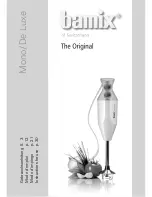
8
AM442D/AM642D
15. Power Connector
This port is for the addition of a power cable, allowing
power to be supplied to the mixer. Please use the
power cable that is included with this mixer only.
Controls and Settings
Rear Panel
16. Phantom Power Switch
When this switch is in the on position, it activates
+48V of phantom power for all microphone inputs,
allowing condenser microphones (well, the ones that
don’t use batteries) to be used on these channels.
Activating Phantom Power will be accompanied by
an illuminated LED above the left channel Level
Meter. Before turning Phantom Power on, turn all
level controls to a minimum to avoid the possibility of
a ghastly popping sound from the speakers.
NB. Phantom Power should be used in conjunction
with balanced microphones. When Phantom Power
is engaged, single ended (unbalanced) microphones
and instruments should not be used on the Mic
inputs. Phantom Power will not cause damage to
most dynamic microphones. If unsure, however, the
microphone’s user manual should be consulted.
17. Power Switch
This switch is used to turn the mixer on and off.
Ensure you turn all level controls down before
activating.
Channel Controls
18. Low Cut Filter (75 Hz)
This button will activate a high-pass filter that reduces
all frequencies below 75 Hz at 18 dB per Octave,
helping to remove any unwanted ground noise or
stage rumble. This Low Cut Filter is only available on
Mic channels on both the AM 442D and AM 642D.
19. Line/Mic Gain Control
This controls the sensitivity of the input signal of the
Line/Microphone input. The gain should be adjusted
to a level that allows the maximum use of the audio,
while still maintaining the quality of the feed. This can
be accomplished by adjusting it to a level that will
allow the peak indicator occasionally illuminate.
20. High Frequency Control
This control is used to give a shelving boost or cut of
±15 dB to high frequency (12 kHz) sounds. This will
adjust the amount of treble included in the audio of
the channel, adding strength and crispness to sounds
such as guitars, cymbals, and synthesizers.
21. Middle Frequency Control
This control is used to provide a peaking style of
boost and cut to the level of middle frequency sounds
at a range of ±15 dB. These mixers also provide
a sweep control, allowing you to select a center
frequency between 100 Hz and 8 kHz. Changing
middle frequencies of an audio feed can be rather
difficult when used in a professional audio mix, as
it is usually more desirable to cut middle frequency
sounds rather than boost them, soothing overly harsh
vocal and instrument sounds in the audio.
The stereo channels feature High-Mid and Low-Mid
controls instead of the typical controls described
above. They provide a peaking style of boost and cut
to middle frequencies, where the frequencies are set
at 3 kHz and 800 Hz, respectively.
22. Low Frequency Control
This control is used to give a shelving boost or cut
of ±15 dB to low frequency (80 Hz) sounds. This will
adjust the amount of bass included in the audio of
the channel, and bring more warmth and punch to
drums and bass guitars.
23. AUX Control
This control alters the signal level that is being sent
to the auxiliary 1 mixing bus, the signal of which
is suitable for connecting stage monitors, allowing
artists to listen to the music that is being played.
Also included is a Pre/Post button which alternates
the feed to the AUX mixing bus between a post and
pre-fader feed.









































